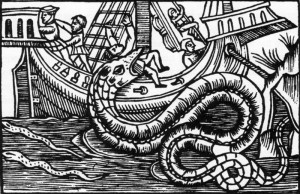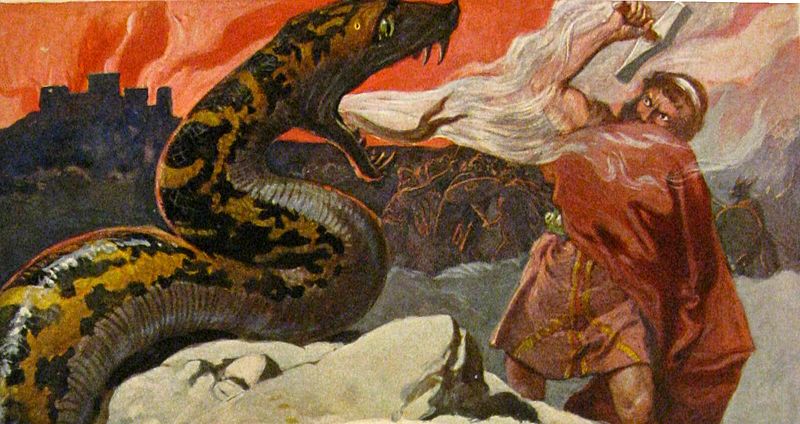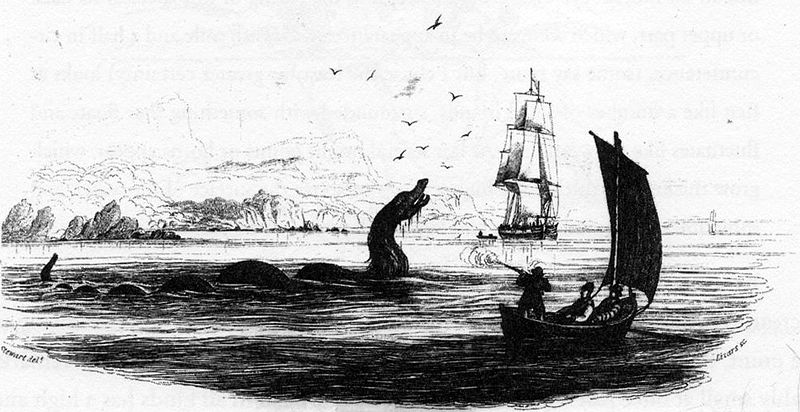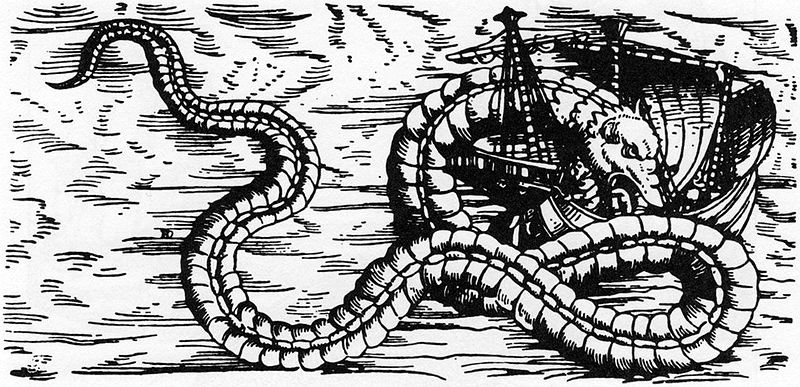The legend of Lagarfljót. Posted by hulda on Oct 23, 2013 in Icelandic culture, Icelandic history
It’s not long now until Halloween so let’s get in the mood of it and have a look at more Icelandic monsters. This time I’ll be concentrating on one particular monster that, unlike the others, has been seen on regular intervals up to our day: the Lagarfljótsormurinn (= the worm of Lagarfljót).
What’s known of this creature is that it’s a lindworm or a lyngworm of origin, snake-like in appearance according to the eyewitnesses and gigantic in size. Lindworms are a type of a Nordic dragon but instead of fire they spit poison, and Lagarfljótsormurinn is no exception to this. In fact spitting poison is known to be its most typical way of hunting its favourite prey, humans. It does kill sheep too but perhaps they aren’t big enough for it because Lagarfljótsormurinn really is said to be one huge beast, one statement saying it can stretch all the way across Lagarfljót, which would make the length of its body about 30km!
Knowing its kind this may not be surprising, since lindworms have a tendency of growing to any size, the largest and the most famous of them, Jörmungandur/Miðgarðsormur being said to be large enough to circle the whole world. The most well-known of its killings is still to happen… that will of course be Þór who cuts down the snake at Ragnarök but dies himself because of the worm’s poison.
The legend of our snake says that it was originally very small in size until it was used to create more gold. Lindworms are known for this particular magical quality, that if you set one over a piece of gold it will grow and the amount of gold underneath it will multiply so that the worm is always lying on a bed of gold. The downside, which really is not a small one, is that it won’t ever stop growing as long as it has the gold underneath it. It’s also virtually impossible to kill once its size reaches a certain point because its skin is tough and also because of the aforementioned capability of spewing poison on its attackers. I would therefore advice against this way of gaining wealth, it’s likely to end in tears and a huge monster beast that not only is dangerous to approach but also needs a lot of meat to feed on!
How come there are still Icelanders left to live on this island and especially near Lagarfljót, you say? That’s because the snake is actually not free to swim around as it pleases. The locals, after losing too many sheep and men to the beast, invited two Finns* over to help take care of it. They did not succeed in killing the worm as their original plan had been, but they still managed to tie its head and tail to the bottom of the glacial river/lake.
Even though Lagarfljótsormurinn is no longer able to wreck havoc it still occasionally moves itself, causing strange, large waves to appear out of nowhere. It can also push up its back and lift it out of the water, which has traditionally been taken as a sign of a disaster about to fall on the country as a whole.
Now to the most interesting part though: this snake has been seen by a great amount of people, many of them considered very reliable as witnesses, and strange things happen at Lagarfljót on occasion. In 1963 for example the head of the National Forest Service, Sigurður Blöndal, claimed to have seen a long streak undulating through the water, breaking the surface on occasion. Unwilling to declare it a legendary monster he nevertheless has not been able to explain what the thing he saw could possibly have been. In 1998 a group of students and their teacher saw a long, white, snake-like form in water. It was in their sight for a good while, some saying for about 25 minutes.
“Þegar ég sá Lagarfljótsorminn sólargeislar voru að hverfa bak við fjöllin, þá voru smábárur á Fljótinu, allt í einu birtist hvít bunga upp úr Fljótinu og var í smátíma og hvarf svo rólega oní Fljótið aftur, þá komu smáöldur frá orminum.”
~Valdís Lilja Andrésdóttir
“When I saw Lagarfljótsormurinn, rays of sun were disappearing behind the mountains, then there were small waves in the Fljót, all of a sudden appeared a white bump from the Fljót and was there for a short while and then calmly went back into the Fljót again, then there were small ripples from (where) the worm (had been).”
The most interesting story that I’ve heard dates in 1983 when the area was laid with telephone cable. The head of the group, Valdimar Benediktsson, described an odd anomaly that occurred while they were performing depth measuring at a part of the lake where the cable had to cross it under water. It seemed like an organic mass, shifting around, he said, but writing it off as a mistake they laid the cable anyway. At this point it may bear telling that the part of the cable that was to be laid into the water had been strengthened to help avoid knots and kinks in it.
The group of workers were skilled, experienced men and there was nothing that hinted anything was amiss while the cable was being laid. Yet, when it was in place and tested it was noticed that the connection did not work. The cable was lifted back up to check what the problem was… and it came back up broken in 22 places at exactly the point where the strange, shifting mass had been recorded. As Valdimar himself sees it they probably accidentally laid the cable over the belly of the beast, if not straight into its mouth!
Here’s the story of the worm’s origins. English subtitles are available. 🙂
The local people who live by the Fljót sure aren’t taking any risks. They’d rather not disturb the monster be it real or imaginary, and as an example although there are fish in the lake they are occasionally believed to be inedible or even poisonous. Definitely no large scale fishing occurs there and although worm-tourism is encouraged** it’s also regulated. The mysterious water monster sightings have not all been explained, nor are they possible to explain by any logical means.
The last time the creature made an appearance it caused quite a stir in the Western world because it was caught on video! Still remember this? (link)
*Most likely Sami in reality. Many old texts call Sami people Finns, but on the time of these texts’ origin the people now called Finns lived much further south.
**If you have a monster, why not share. Especially during its feeding season. *wink**nudge**wink*

Build vocabulary, practice pronunciation, and more with Transparent Language Online. Available anytime, anywhere, on any device.
About the Author: hulda
Hi, I'm Hulda, originally Finnish but now living in the suburbs of Reykjavík. I'm here to help you in any way I can if you're considering learning Icelandic. Nice to meet you!








